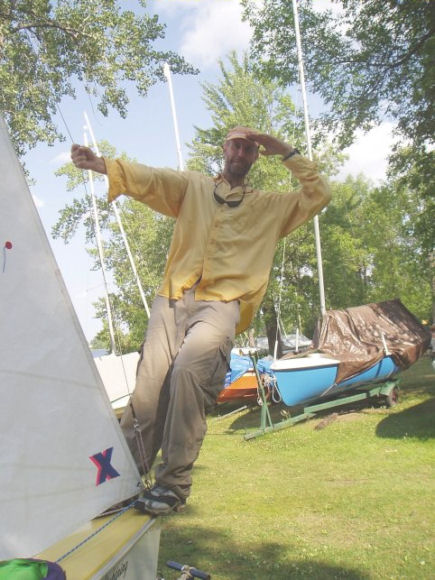|
There are three
main benefits
of doing a proper job of setting your sails:
The genoa/jib: We hoist this first. It is smaller and easier to deal with while the main is still down. It is essential to good upwind performance to have the jib halyard up tight enough so that the leeward shroud does not hang (very) loose when you sail close-hauled. If there is significantly too little jib halyard tension, the jib luff develops a hook that makes it impossible to point well. Most
racing
Wayfarers use a
tensioning device such as a "Magic/Muscle Box" or a Highfield lever to
tension a low-stretch halyard. N.B.
Beware of over-tensioning the jib halyard as this may flatten your jib
luff entry in a way that narrows your "groove" to the point where
performance
suffers even more.
The
rule of thumb is: Tension the halyard until the leeward
shroud
is just on the edge of losing its slack while you are sailing
close-hauled.
If you find that your jib luff tickers are too jumpy, i.e. they
indicate
you are luffing and stalled (too far off the wind) at virtually the
same
time, your jib luff entry is too flat and you must reduce jib halyard
tension
until the problem with the tickers is resolved (in very bouncy
conditions
this may mean a slack lee shroud!)
 Without the aid of a mechanical advantage, it is difficult to get adequate tension, but you can get closer by having someone hang over the bow off the forestay to pull the mast forward (see photo above) while the other crew member hoists and cleats the halyard as tightly as possible. But be a bit cautious on this - I bent a CL16 mast once, using that method. OTHER NEEDS for the jib are good cleats and soft braid jib sheets that will cleat well and be kind to your hands.
The mainsail: Unless you have a main that is much smaller than the rules allow, you should hoist your main virtually to the top of your mast (to the "black band" if you race!) This sounds simple but can easily become impossible, unless you remove any forces that may cause the main to get stuck as you hoist. On W3854, we always do the following as we hoist the main: 1. hold the boat
head to wind
with the centreboard fully raised to allow the boat to stay head to
wind
easily OTHER NEEDS are:
boat &
sail
trim |